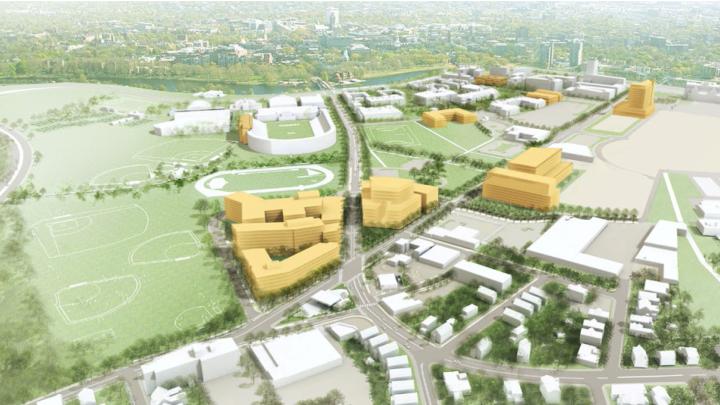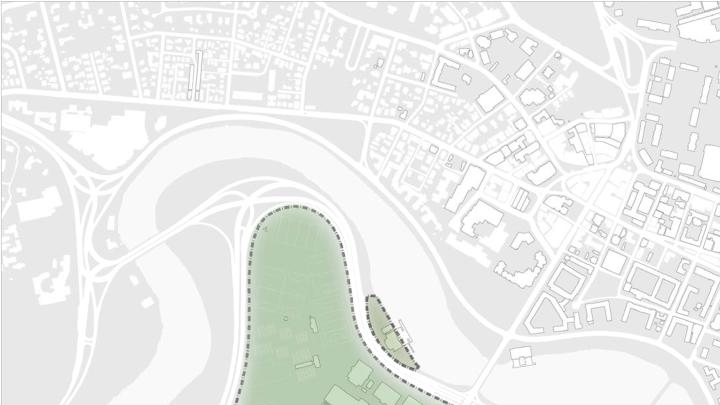After more than two years of intensive planning and community discussions, the University has filed a 10-year Institutional Master Plan (IMP) with the Boston Redevelopment Authority (BRA), detailing 1.4 million square feet of projects that administrators say “provide a long-term vision” for Harvard’s expanding campus across the Charles River in Allston.
The IMP contains nine major projects—some under discussion since the 1990s—that the University hopes to complete during the next 10 years if granted approval. Among them: an addition to Harvard Stadium; a new basketball gymnasium that will be built between 2017 and 2022; a 150- to 250-room hotel/conference center located across the street from the south side of the Harvard Business School (HBS) campus; and various renovations and additions to HBS's facilities, such as a new auditorium for Burden Hall, faculty and administrative office buildings, and renovation of the Soldiers Field Park Housing complex, adjacent to HBS. A preliminary form of the IMP submission, including these projects, was unveiled in October 2012 as a basis for community discussion and negotiations. The nine-building plan also includes a section dedicated to community benefits, such as proposals for transportation improvements, education programs, and neighborhood open spaces.
“This comprehensive plan will expand Harvard’s academic presence in Allston and build upon the shared goal of extending community programming, improving infrastructure and the public realm, and creating a new nexus where campus and community meet,” states the news release from the office of executive vice president Katie Lapp, who oversees Allston work. “The plan includes approximately 1.4 million square feet of new construction, building replacement, and renovation projects that support academics, research, executive education, assembly, office, hospitality, retail, culture, and housing.” Now that the IMP has been filed with the city, University officials say they hope to gain approval for the projects sometime this fall.
The IMP does not include the Health and Life Sciences Center (already approved under the previous IMP), slated for groundbreaking in 2014 (and now intended to be a new home for the School of Engineering and Applied Sciences), nor the Barry’s Corner Housing/Retail Commons slated for groundbreaking later this year and scheduled to open in 2014.
In a separate Allston project not included in this IMP, this past March the Boston Redevelopment Authority voted unanimously to allow the University to move its campus-services facilities to 28 Travis Street in North Allston, to make way for planned development on the existing site (at the corner of Western Avenue and North Harvard Street). The Travis Street facility—which will include campus police training, information technology, recycling, furniture storage, and fleet management—will likely become Harvard’s first completed project in Allston since the University announced plans to resume construction there last year.
As Mayor Thomas Menino prepares to leave office, developers rushing to take advantage of the improved economic environment and strong local demand for housing are “lining up to seek key approvals for billions of dollars of mega projects before the election of a new mayor who could upend or delay their plans,” according to a Boston Globe report published July 21. Boston’s mayor and the BRA exercise significant control over development approvals. Harvard’s Allston plans have been prepared and reviewed by the community for several years, and are following a long-established timetable; even so, the IMP review will take place in the context of this development boom and the first change in the mayor’s office in two decades. (Menino was awarded an honorary degree at Commencement this past May.)
Harvard officials have previously stressed that the IMP projects would be complementary to the University’s aspirations for Barry’s Corner (at North Harvard Street and Western Avenue). “We will be working very hard in our planning to make sure the ground plan, pathways, and streets work to connect these projects effectively to Barry’s Corner so that it is an intuitive connection,” Harvard’s director of physical planning, Harris Band, said in October 2012, adding: “This is a very diverse variety of projects in terms of use, including executive education, classrooms, faculty and administrative offices, a hotel and conference center, housing, retail, and other ground-floor uses and open space. That variety is very important because it combines to make for a very dynamic area.”
Still, some Harvard-Allston Task Force members have expressed concern about the University’s overall vision for Allston, saying the Barry’s Corner project will not be the community hub the University is promising. “For 15 years this has been held out by Harvard and the city as being this wonderful, thriving town center of our community which has never had such a town center,” said Task Force member and longtime Allston resident Harry Mattison in a recent interview with Harvard Magazine. “Harvard’s idea of Barry’s Corner is a basketball arena, some sort of office building, a giant parking lot…None of those things are going to make this area great. None of them will make this area even good.” Residents have asked Harvard to address questions about retail and cultural amenities, transportation (including residents’ use of the Harvard Shuttle service), parking, housing affordability, and public-space planning, as well as about promised “transformative community projects,” before moving forward with construction.
Mattison also expressed frustration that the University is not addressing residents’ concerns about increased traffic brought to the area by the new development. “Harvard claims that somehow all of their new projects will lead to less traffic than we have today,” he said. “They are making wild claims to get away with investing as little as possible in the roads and transportation system their campus really needs…As anyone who gets off at the Allston exit knows, it’s already a mess.”
Harvard officials expressed enthusiasm at taking the “next step forward in the regulatory review process,” and maintain the IMP will “activate Barry’s Corner, improve area circulation, and enhance the public realm with new sidewalks, streetscape, landscape, and civic spaces—creating new gathering and social spaces for the university and the community.”
“The document outlines a plan that combines academic priorities, retail development, open space enhancement, and pedestrian connections that will enliven Barry’s Corner and create stronger ties with our Cambridge campus, and between the University and its neighbors,” writes Lapp. “The plan has benefited from eight months of public engagement and shows the next phase in the evolution of a campus where students, faculty, staff and the community can learn, live, work, and play together.”









